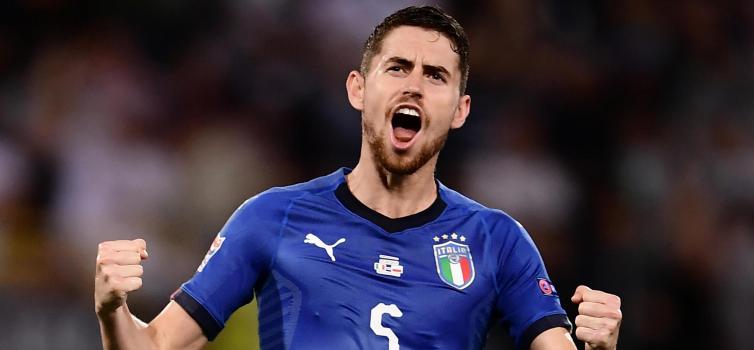Jorginho and a new breed of playmaker

Jorginho: An essential component of the team, both offensively and defensively
Written by Simon Austin — September 14, 2021
“The playmaker is no longer the number 10." (Fabio Capello)
A team’s creative fulcrum - or playmaker - used to be their attacking midfielder, or number 10.
Think Diego Maradona, Johan Cruyff, Zinedine Zidane. However, Uefa’s excellent Technical Report on Euro 2020 has effectively sounded the death knell for this particular position.
“The playmaker is no longer the number 10,” states former England, Russia and AC Milan manager Fabio Capello in the report.
Peter Rudbæk, former Head Coach of Aalborg, Aarhus and Viborg, expands.
“In the old days, the playmaker was a number 10 in the number 10 position,” he says. “It is important to define what a playmaker is in modern terms. Wearing number 10 is more about the history.
"Now, it’s more about the ability to dictate tempo and make a pass towards the final third for another team-mate to supply the final pass. You have the players who can dictate the game and put the other players in a position to assist. Nowadays, the assist is coming up front.”
There are a number of reasons for this decline of the attacking midfielder as creative key.
“Teams are very compact out of possession now, so there is more space in deeper areas,” Dave Adams, Technical Director of the Welsh FA, tells TGG. “The key creative area used to be zone 14, but teams have plugged that.”
From the ashes of the number 10 rises a new type of playmaker: the deep-lying midfielder. The standard bearer for this position is Italy and Chelsea’s Jorginho, with Uefa’s Technical Report reading like an homage to him.
In his analysis of the Euro 2020 final, former Austria Technical Director Willi Ruttensteiner splits the game into two halves: one in which England managed to nullify Jorginho, and the other in which the player was able to dominate. This is ultimately where the game was won and lost.
“At the beginning, Mason Mount and Raheem Sterling were pressing up to prevent Italy’s centre-backs from playing to their playmaker, Jorginho,” Ruttensteiner explains.

Jorginho average position (in and out of possession)
“If he got the ball, he had to deal with pressing by Declan Rice and Kalvin Phillips. So they (Italy) couldn’t use him. After half time, their positional play was much better and Jorginho was able to get on the ball and become the absolute leader on the pitch.”
There were a number of reasons for this transformation. Firstly, a number of tactical switches made by Italy coach Roberto Mancini. The report details how the Italy manager: pushed Marco Verratti further forward, pressing Rice and Phillips and asking more questions of the duo; moved Nicolo Barella forward on the right; instructed Federico Chiesa to carry the ball more; and brought on Domenico Berardi for Ciro Immobile after 55 minutes, enabling Lorenzo Insigne to play between the lines as a false number nine.
In turn, England became more and more cautious. They dropped into a low block and played more direct. In the words of former Middlesbrough manager Aitor Karanka, who watched the tournament as an observer for Uefa: “When you are winning a game, you can easily become scared to lose it, especially when you have to manage the pressure of playing in front of your home crowd as a young team.”
England’s possession dropped to 35%; one in four of their passes went astray; their average pass distance extended to 35 metres; and keeper Jordan Pickford made 26 long clearances after the interval.
All of this enabled Jorginho to assume control for his side. Uefa reveal he made 98 passes after half time - more than the entire England midfield put together.
The Chelsea midfielder’s stats for the Euros as a whole are also insane. He was a mainstay for his side, playing in all seven of their matches (alongside only Leonardo Bonucci, Gianluigi Donnarumma and Chiesa) and topped their charts for both passes - 519 attempted, 93% success rate - and also defending - 48 balls recovered and 25 interceptions.
The average distance Jorginho covered per game in the Euros was second only to Spain’s Pedri, at 12.35km, as was the total distance covered in possession, 33.12km.
“The deep midfield role does not usually receive the appreciation it warrants,” explains the Uefa Technical Report. “It is an essential part of the team, both defensively and offensively.”
Former Spain U20 coach Gines Melendez added: “Jorginho and Sergio Busquets are fundamental players in their teams, as they give balance to the side in every meaning of the word.”
In summary, this was the tournament of Jorginho and a new breed of playmaker.




-1.png)





